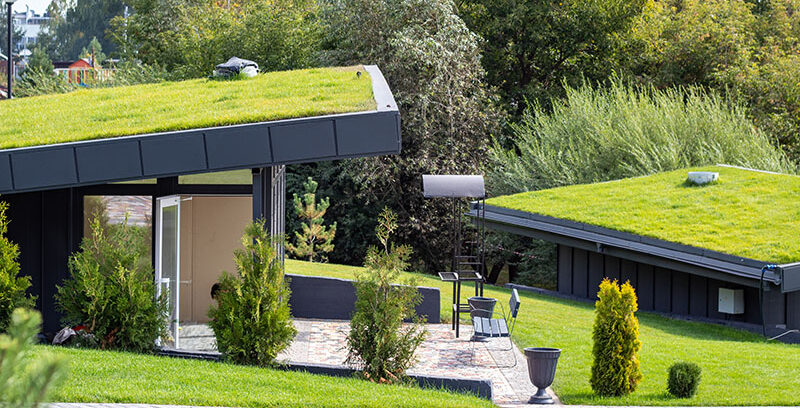
Green roofing, epitomizing the confluence of modern architecture and sustainable design, has emerged as a pivotal solution in the face of increasing urban sprawl and environmental degradation. This innovative approach transcends the traditional roofing paradigms, integrating living elements with built environments to foster ecological balance and sustainability. As cities expand and the pressure on natural resources intensifies, the need to contact a roofing service company proficient in green roofs becomes imperative, not just as a fleeting trend but as a fundamental shift towards resilient urban development.
Green roofs are not only about planting vegetation atop buildings; they represent a holistic strategy that blends nature and technology, aiming to create energy-efficient, biodiverse, and sustainable urban habitats. By adopting green roofs, cities can combat the heat island effect, enhance air quality, and provide serene green spaces for their inhabitants, thereby crafting a sustainable blueprint for future generations.
Table of Contents
The Rise of Green Roofing
Green roofing has journeyed from ancient practices to a cornerstone of contemporary sustainable design. Initially, these roofs were simplistic, covered with earth and vegetation to provide insulation. However, the evolution has been profound, with modern green roofs serving as multifunctional spaces that contribute significantly to urban ecosystems.
Historical Evolution of Green Roofs: The historical trajectory of green roofs reveals a rich tapestry of innovation driven by necessity and environmental consciousness. From the hanging gardens of Babylon to the sod roofs of Scandinavia, each phase of evolution was a step towards today’s sophisticated systems. These historical antecedents laid the groundwork for the green roofs we see today, which are complex assemblies designed for environmental resilience.
Current Trends and Drivers in Green Roofing: The ascendancy of green roofing in the architectural realm is underpinned by a confluence of factors. Environmental concerns, regulatory mandates, and societal shifts towards sustainability fuel this upward trajectory. Urban centers, faced with the adverse effects of concrete jungles, have turned to green roofs as a panacea, creating verdant havens that mitigate pollution, enhance biodiversity, and improve the quality of life for urban dwellers.
Benefits of Green Roofing
Environmental Advantages: Green roofs serve as a bulwark against the urban heat island effect, reducing the temperature disparity between urban and rural areas. They enhance biodiversity, providing sanctuary for a variety of flora and fauna, and play a crucial role in stormwater management, reducing runoff and sewage system load.
Economic Incentives: The installation of green roofs translates into tangible economic benefits. They prolong roof lifespan, decrease energy costs through improved insulation, and can augment property values. The long-term financial savings and potential revenue generation from green roofs present a compelling case for their adoption.
Social and Health Benefits: Beyond their environmental and economic merits, green roofs have profound social and health implications. They offer urbanites much-needed green spaces, promoting physical activity, mental well-being, and social cohesion. The psychological uplift from interacting with nature, even in an urban setting, is invaluable.
Technological Advances in Green Roofing
Innovative Materials and Designs: The advent of lightweight, sustainable materials has revolutionized green roof construction. Modern designs prioritize not only ecological benefits but also aesthetic and functional aspects, seamlessly integrating green roofs into the urban fabric.
Water Management and Irrigation Systems: Cutting-edge irrigation and water management systems ensure that green roofs are sustainable and resilient. These systems optimize water use, support plant life, and contribute to the overall efficiency of green roofs.
Integrating Renewable Energy Sources: The synergy between green roofs and renewable energy technologies, like solar panels, exemplifies the innovative spirit of sustainable construction. This integration enhances the energy efficiency of buildings and reduces their carbon footprint.
Challenges and Solutions in Green Roofing Implementation
Structural and Maintenance Considerations: The implementation of green roofs necessitates meticulous planning to address additional weight and maintenance needs. Ensuring the structural integrity of buildings and the longevity of the green roofs is paramount for their success.
Regulatory Hurdles and Incentive Programs
The regulatory environment can be a maze, with varying requirements and incentives across jurisdictions. Developing clear, supportive policies and programs is crucial to foster the widespread adoption of green roofing.
Future of Green Roofing in the Construction Industry: The trajectory of green roofing is set towards greater integration, innovation, and impact, marking a pivotal shift in the construction industry’s approach to sustainability.
Predictions and Emerging Trends
The future trajectory of green roofing is poised to be defined by significant technological innovations, particularly through the incorporation of smart technologies aimed at optimizing monitoring and maintenance processes. As we advance, the emphasis is expected to shift towards the creation of multifunctional spaces that are not only environmentally sustainable but also yield substantial social and economic advantages. These spaces are envisioned to be dynamic ecosystems that integrate solar panels, rainwater harvesting systems, and biodiversity enhancements, contributing to urban resilience and sustainability.
Furthermore, smart sensors and IoT (Internet of Things) integration will enable real-time data analysis, ensuring optimal performance and longevity of green roofs. This evolution will lead to buildings that not only reduce carbon footprints but also improve the quality of life for urban residents, fostering communities that are in harmony with their natural surroundings while promoting economic growth and environmental sustainability.